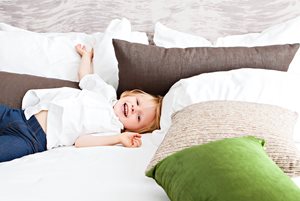Designing a Babyproof Home

If you have a new baby or toddler and you are excited about moving to a new home, then chances are, one of the biggest tasks you are working on is babyproofing the place. In order to do so, it is important to be aware of the biggest risks your home can pose. Some of the most common causes of pediatric injury include small food and other items lying about (which can pose a choking risk), exposure to toxic chemicals, burns, and falls. Sharp furniture can also hurt toddlers while they are learning to walk. Take the time you need to research potential safety threats so you have time you need to create a safe and beautiful home for your baby and the entire family.
How to Reduce the Chances of Falls?
Stairs are a major cause of falls in the home for people of all ages. Baby gates will prevent these, but you should also reduce the chance of tripping by keeping your home tidy and removing tripping risks such as small rugs. The floor should be completely clear of small toys and other items that can hurt tiny feet. Your choice of flooring is key. Wall-to-wall carpet is arguably the snuggliest material around, but it is difficult to clean and quickly become the home of dust mites and other allergens. Hardwood and bamboo are good options for easy cleaning and durability.
Injuries in Common Areas and Bathrooms
To keep your baby completely safe, look around every single room and identify possible accident risks. Little fingers can easily get trapped in doors, for instance, so use door finger safety guards throughout. In the bathroom, keep medication, razors, and any other items children might get their hands on in a childproof cabinet. Toilets should have a toilet lock to prevent toddlers from falling in. Ensure you have a large enough cabinet for hairdryers and any other plugged devices, to avoid these falling into the tub while someone is in it. Set your hot water heater to a low temperature to avoid scalding.
Preventing Burns and Injuries in the Kitchen
Children can get curious about kitchen equipment so make sure that controls for your hob are close to the wall and therefore out of reach of children. If you have an existing hob that has reachable controls, use special covers to keep little hands from getting burned. Your kitchen should have sufficient storage furniture for electrical equipment (such as hand mixers, beaters, and the like), since children can become attracted to these items and accidentally turn them on. All cleaning solutions should be stored out of the reach of children; use higher cabinets for this purpose, as well as childproof doors.
Furniture Stability
Cabinets and other furniture for storage should be affixed to the wall so they do not fall on top of a baby or small child. Be careful of any furniture pieces you have on wheels; babies or toddlers can pull these towards them and hurt their toes or feet. Affix your television to the wall and anchor bookshelves and free-standing TVs to the wall.
When it comes to childproofing your home, it pays to spend a few hours on research, since there are many potential hazards you may have thought of. Be extra vigilant of the main places where accidents occur, including the kitchen and bathroom. Cover all sharp, pointy furniture with soft guards, and consider softer flooring for less painful bumps when falls do occur.
This article has been written by Jackie Edwards.